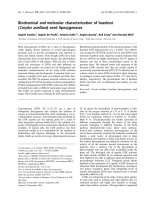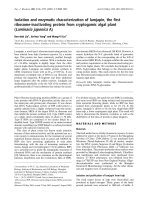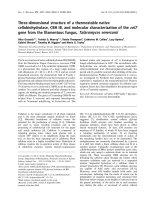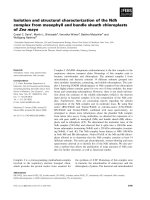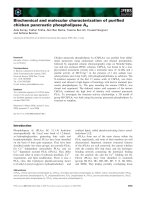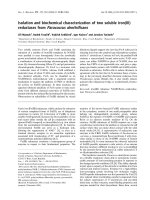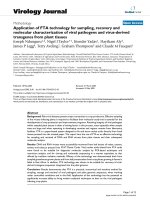Isolation and molecular characterization of genes associated with shoot regeneration of mustard (brassica juncea) in vitro
Bạn đang xem bản rút gọn của tài liệu. Xem và tải ngay bản đầy đủ của tài liệu tại đây (7.41 MB, 233 trang )
ISOLATION AND MOLECULAR CHARACTERIZATION
OF GENES ASSOCIATED WITH SHOOT
REGENERATION OF MUSTARD (
BRASSICA JUNCEA
)
IN VITRO
GONG HAIBIAO
NATIONAL UNIVERSITY OF SINGAPORE
2003
ISOLATION AND MOLECULAR CHARACTERIZATION
OF GENES ASSOCIATED WITH SHOOT
REGENERATION OF MUSTARD (BRASSICA JUNCEA)
IN VITRO
GONG HAIBIAO
(M.Sc. SJTU)
A THESIS SUBMITTED
FOR THE DEGREE OF DOCTOR OF PHILOSOPHY
DEPARTMENT OF BIOLOGICAL SCIENCES
NATIONAL UNIVERSITY OF SINGAPORE
2003
ACKNOWLEDGEMENTS
I would like to express my utmost gratitude to my supervisor, Assoc. Prof. Pua
Eng Chong for his invaluable advice, guidance and support throughout my research
work over the past several years.
I would also like to extend my sincere thanks to my fellow colleagues in Plant
Genetic Engineering Laboratory, Carol, Cheng Wei, Emily, Francis, Huiping, Liu Pei,
Mo Hua, Serena, Shuzhen, Wenwei, Yuxia and Dr. Liu Jianzhong for creating a
helpful and joyful working environment.
I appreciate the help and advice from my friends in other laboratories, Yu Hao,
Shuhua, Fuquan and Zhilong.
Last but not least, I would like to thank my family, especially my wife, Tong
Li, for their love, encouragement and constant support, without which completion of
this project would not have been possible. This thesis is also dedicated to my lovely
son, Chuwei, who always brings me laughter, joy and strength.
i
TABLE OF CONTENTS
Pages
Title
Acknowledgements i
Table of contents ii
List of abbreviations vii
List of tables xi
List of figures xii
Summary xv
1 General introduction 1
2 Literature review 5
2.1 Occurrence and regulation of morphogenic events in vitro 5
2.1.1 Somatic and microspore embryogenesis 5
2.1.2 Organogenesis 6
2.2 Plant morphogenesis in vitro in relation to ethylene 7
2.2.1 Regulation of ethylene biosynthesis and action 8
2.2.1.1 Ethylene biosynthesis 8
2.2.1.2 Ethylene signal transduction pathway 10
2.2.1.3 Relationship between ethylene and other 12
signaling pathways
2.2.2 Role of ethylene in plant morphogenesis 14
2.2.2.1 Shoot organogenesis 14
2.2.2.2 Somatic embryogenesis (SE) 16
2.3 Metabolic linkage between ethylene and polyamines (PAs) 16
2.3.1 PA metabolism 17
2.3.2 Role of PAs in plant morphogenesis in vitro 19
2.3.2.1 Shoot organogenesis 19
2.3.2.2 Somatic embryogenesis 20
2.4 Stress in relation to ethylene and PAs 22
2.4.1 Effects of ethylene 22
2.4.2 Effects of PAs 23
2.4.3 Oxidative stress 24
2.4.3.1 Occurrence and scavenging of ROS 24
2.4.3.2 H
2
O
2
signaling 28
2.4.4 Plant regeneration in relation to stress/ H
2
O
2
30
ii
2.5 Genetic control of regeneration 32
2.5.1 Genotypic variability in Brassica spp. 32
2.5.2 Genes involved in shoot organogenesis 33
2.5.3 Genes involved in SE 35
3 Materials and methods 38
3.1 Plant materials 38
3.1.1 Brown mustard (Brassica juncea (L.) Czern and Coss) 38
3.1.2 Arabidopsis thaliana 38
3.2 Chemical treatments 39
3.3 Shoot regeneration from cultured explants 39
3.4 Gene cloning 41
3.4.1 Cloning of polymerase chain reaction (PCR)-amplified 41
products
3.4.2 Bacterial transfection 41
3.4.3 Plasmid DNA isolation 43
3.4.4 DNA sequencing and analysis 44
3.5 Probe labeling 44
3.5.1 DNA probes 44
3.5.2 RNA probes 46
3.6 Genomic DNA isolation and Southern analysis 46
3.7 RNA isolation and northern blot analysis 47
3.7.1 TRI REAGENT method 47
3.7.2 CTAB method 48
3.7.3 Northern blot 48
3.8 mRNA differential display 49
3.9 Quantitative Reverse Transcription PCR (RT-PCR) 50
3.10 Cloning of Full-length cDNA by rapid amplification of cDNA 51
ends (RACE)
3.10.1 5’-RACE 51
3.10.2 3’-RACE 52
3.10.3 Generation of full-length cDNA sequences 52
3.11 Cloning of the promoter sequence 53
3.11.1 Construction of GenomeWalker libraries 53
3.11.2 Cloning of BjGSTF2 and SRKKK promoters by 53
Genome Walking strategy
3.12 Construction of chimeric genes 55
3.12.1 Generation of sense and antisense constructs 55
iii
3.12.2 Generation of double-stranded construct 56
3.12.3 Generation of BjGSTF2 promoter:GUS fusions 58
3.13 Genetic transformation of Arabidopsis plants 58
3.14 Biochemical analysis 61
3.14.1 Histochemical assays for the GUS activity 61
3.14.2 GUS fluorometric assay 62
3.14.3 Ethylene measurement 62
3.14.4 Histochemical detection of H
2
O
2
63
3.15 Bioinformatics tools used for sequence analysis 63
4 Identification and expression of genes associated with shoot 65
regeneration from leaf disc explants of mustard (Brassica juncea)
in vitro
4.1 Introduction 65
4.2 Results 68
4.2.1 Shoot regeneration from leaf disc explants 68
4.2.2 Identification of cDNAs differentially expressed in tissues 68
4.2.3 Categorization of cDNAs 71
4.2.4 Characterization of cDNAs 76
4.2.5 Effect of H
2
O
2
79
4.2.6 Endogenous H
2
O
2
content in tissues during culture 81
4.3 Discussion 84
5 The cloning of a phi class glutathione S-transferase gene and 90
effects of regulation of its expression on shoot regeneration and
stress response
5.1 Introduction 90
5.2 Results 93
5.2.1 Cloning and sequence analysis of GST genes from 93
mustard
5.2.2 Multiple members in the mustard genome and their 93
relationship with other phi class GSTs
5.2.3 Expression of GST genes in different mustard organs 103
5.2.4 GST expression in response to various treatments 103
5.2.5 Generation of transgenic plants expressing sense, 108
antisense and double-stranded GST cDNAs
5.2.6 Flowering and stress response in transgenic plants 110
5.2.7 Shoot regeneration response and ethylene production of 113
cultured tissues in relation to GST expression
5.3 Discussion 119
iv
5.3.1 Characteristics of GSTs 119
5.3.2 GST expression and its regulation 120
5.3.3 Changes in GST expression affect stress tolerance and 122
flowering
5.3.4 Role of GSTs in plant morphogenesis in vitro 124
6 Cloning and characterization of the promoter of a phi class 127
glutathione S-transferase gene by 5’- deletion analysis
6.1 Introduction 127
6.2 Results 129
6.2.1 Molecular cloning of the BjGSTF2 promoter 129
6.2.2 Generation of transgenic plants expressing the GUS 129
gene conferred by different BjGSTF2 promoters
6.2.3 Organ specific expression 131
6.2.4 Changes in the transgene activity conferred by different 133
BjGSTF2 promoters in response to H
2
O
2
, ACC, SA
and spermidine
6.2.5 H
2
O
2
accumulation and GUS activity in leaf discs during 134
shoot regeneration in vitro
6.3 Discussion 138
6.3.1 Characterization of BjGSTF2 promoter 138
6.3.2 Spatial gene expression in transgenic plants 138
6.3.3 Transgene expression in response to treatments 140
6.3.4 GUS expression is associated with H
2
O
2
accumulation 143
in transgenic tissues
7 Isolation and characterization of a Raf-related MAPKKK gene 145
from mustard
7.1 Introduction 145
7.2 Results 149
7.2.1 Cloning and sequence analysis of SRKKK gene 149
7.2.2 SRKKK is a homolog of MAPKKK 153
7.2.3 Expression of SRKKK during shoot regeneration 158
7.2.4 SRKKK expression in different organs 161
7.2.5 SRKKK expression in response to treatments 161
7.2.6 Generation of transgenic plants expressing sense SRKKK 164
7.2.7 Selection of Arabidopsis AtSRKKK mutants 166
7.2.8 Expression of PDF1.2, AtVSP and AtGSTF2 in SRKKK 168
overexpressor and mutant
7.2.9 Effects of high concentrations of hormone/chemical 170
treatments on root growth of SRKKK overexpressor and
mutant
7.3 Discussion 172
7.3.1 SRKKK encodes a putative Raf-related kinase protein 172
v
7.3.2 Spatial and temporal expression of SRKKK 173
7.3.3 Correlation with jasmonate (JA) 174
7.3.4 Correlation with GSH 176
8 General discussion and conclusion 179
References 189
vi
LIST OF ABBREVIATIONS
2,4-D 2,4-dichlorophenoxyacetic acid
2-iP 6-(γ,γ-dimethylallylamino)purine
ABA abscisic acid
ACC 1-aminocyclopropane-1-carboxylate
ACO ACC oxidase
ACS ACC synthase
ADC arginine decarboxylase
Agm agmatine
Arg arginine
AgNO
3
silver nitrate
APP 1-(aminopropyl)pyrroline
APX ascorbate peroxidase
A. tumefaciens Agrobacterium tumefaciens
AVG aminoethoxyvinylglycine
BA benzyladenine
bp base pair(s)
CaMV cauliflower mosaic virus
cDNA complementary deoxyribonucleic acid
CAT catalase
CM control medium
CTAB hexadecyl trimethyl-ammonium bromide
DAO diamine oxidase
DAB 3,3-diaminobenzidine
DAP 1,3-diaminopropane
Dc-SAM decarboxylated S-adenosylmethionine
DDRT-PCR differential display RT-PCR
DEPC diethyl-pyrocarbonate
DFM difluoromethylarginine
DFMO difluoromethylornithine
Dc-SAM decarboxylated SAM
DEPC diethy-pyrocarbonate
vii
DHA dehydroascorbate
DHAR DHA reductase
DIG digoxigenin
DMSO dimethyl sulfoxide
DMTU dimethylthiourea
DNA deoxyribonucleic acid
dNTP deoxynucleoside triphosphate
E.coli Escherichia coli
EDTA ethylene-diamine-tetra-acetate
EST expressed sequence tag
g gram(s)
GA gibberellic acid
GABA γ-aminobutyric acid
GM germination medium
GR glutathione reductase
GSH glutathione
GSSG glutathione disulphide
GST glutathione S-transferase
GUS β-glucuronidase
h hour(s)
H
2
O
2
hydrogen peroxide
IAA indole-3-acetic acid
IBA indole-3-butyric acid
IPTG isopropylthio-β-D-galactoside
kb kilo base-pair(s)
Kinetin 6-furfurylaminopurine
LB Luria Bertani
MAPK mitogen-activated protein kinase
MAPKK mitogen-activated protein kinase kinase
MAPKKK mitogen-activated protein kinase kinase kinase
MDHA monodehydroascorbate
MDHAR MDHA reductase
Met methionine
MGBG methylglyoxal-bis-guanylhydrazone
viii
min minute(s)
MJ methyl jasmonate
ml millitre
mRNA messenger ribonucleic acid
MS Murashige and Skoog
mw molecular weight
NAA α-naphthaleneacetic acid
NBT 4-nitro-blue-tetrazolium chloride
NOS nopaline synthase
NPT II neomycin phosphotransferase II
O
2
-
superoxide radical
O.D. optical density
ODC ornithine decarboxylase
ORF open reading frame
Orn ornithine
PA polyamine
PAO polyamine oxidase
PCR polymerase chain reaction
Prq paraquat
Put putrescine
PVP polyvinylpyrrolidone
∆Py ∆
1
-pyrroline
RNA ribonucleic acid
RNase ribonuclease
ROS reactive oxygen species
rpm revolution per minute
RT-PCR reverse transcription PCR
s second(s)
SA salicylic acid
SAM S-adenosyl methionine
SAMDC SAM decarboxylase
SAMS SAM synthetase
35
S -dATP [α-
35
S]-deoxyadenosine 5’ (α-thio)triophosphate
SE somatic embryogenesis
ix
S.E. standard error
SIM shoot induction medium
SOD superoxide dismutase
Spd spermidine
SpdS spermidine synthase
Spm spermine
SpmS spermine synthase
SDS sodium dodecylsulphate
SRKKK shoot regeneration-related MAPKKK
SSC standard saline citrate
Tris tris(hydroymethyl)-aminomethane
UTR untranslated region
UV ultraviolet
v/v volume per volume
w/v weight per volume
X-gluc 5-bromo-4-chloro-3-indolyl-β-D-glucuronic acid
x
LIST OF TABLES
Pages
Table 1.
Chemicals used for treatments. 40
Table 2.
Summary of bioinformatics programs used in this study. 64
Table 3.
cDNAs differentially expressed in cultured leaf discs of mustard
on SIM and CM after 6 days of culture.
72
Table 4.
Shoot regeneration from leaf disc explants of mustard in the
presence of H
2
O
2
.
83
Table 5.
Phi class GSTs in plants resulted from the search in the Genbank
database.
100
Table 6.
Relative root length (%) of SRKKK-S4, WT and srkkk2 plants
in response to various plant hormones and chemicals.
171
xi
LIST OF FIGURES
Pages
Figure 1.
Proposed pathways of metabolic interactions between ethylene,
polyamines and H
2
O
2
synthesis.
9
Figure 2.
Metabolic pathway of ROS generation and scavenging in the
course of oxidative burst in plants.
26
Figure 3.
pGEM
®
-T Easy vector. 42
Figure 4.
Diagrammatic representation of primary and secondary genome
walking.
54
Figure 5.
Chimeric gene constructs carrying BjGSTF2 cDNAs. 57
Figure 6.
Schematic representation of constructs carrying the gene fusions
of the GUS coding sequence and different BjGSTF2 promoters.
59
Figure 7.
Differential shoot regeneration from cultured leaf disc explants
of mustard grown on SIM and CM.
69
Figure 8.
A representative mRNA differential display of cultured leaf
discs of mustard grown on SIM and CM.
70
Figure 9.
Expression of cDNAs in cultured leaf disc explants of mustard
after 6 days of culture.
77
Figure 10.
Time-course expression of cDNAs in cultured explants of
mustard grown on SIM and CM.
78
Figure 11.
Effect of exogenous H
2
O
2
on transcript accumulation of cDNAs. 80
Figure 12.
Localization of H
2
O
2
production in cultured leaf discs. 82
Figure 13.
The nucleotide and amino acid sequences of BjGSTF2. 94
Figure 14.
Genomic DNA gel blot analysis of GST gene in mustard. 96
Figure 15.
Alignment of six mustard GST genes. 97
Figure 16.
Phylogenetic analysis of phi class GSTs. 102
Figure 17.
GST expression in different mustard organs. 104
Figure 18.
GST expression in response to various treatments. 105
xii
Figure 19.
Effect of incubation duration on GST expression in response to
various chemicals.
107
Figure 20.
GST expression in individual transgenic Arabidopsis plants
expressing sense (GST-S), antisense (GST-A) and double-
stranded (GST-DS) GST cDNAs.
109
Figure 21.
Genomic DNA gel blot analysis of transgene in transgenic
Arabidopsis.
111
Figure 22.
Bolting and flowering of WT and different transgenic
Arabidopsis plants expressing sense (GST-S6), antisense (GST-
A4) and double-stranded (GST-DS1) cDNAs.
112
Figure 23.
Phenotype of WT and different transgenic Arabidopsis plants
expressing sense (GST-S6), antisense (GST-A4) and double-
stranded (GST-DS1) cDNAs after stress treatments.
114
Figure 24.
Shoot regeneration from leaf disc explants of Arabidopsis after
30 days of culture.
115
Figure 25.
Ethylene evolution from leaf discs of Arabidopsis during 18
days of culture.
117
Figure 26.
GST expression in WT and transgenic Arabidopsis plants (GST-
S6, GST-A4 and GST-DS1) during shoot regeneration in vitro.
118
Figure 27.
Promoter sequence of BjGSTF2. 130
Figure 28.
Histochemical assay of the GUS activity in transgenic
Arabidopsis plants expressing the GUS gene driven by different
BjGSTF2 promoters.
132
Figure 29.
Effect of treatments on the GUS activity in transgenic
Arabidopsis plants conferred by different BjGSTF2 promoters.
135
Figure 30.
H
2
O
2
accumulation and GUS activity in leaf disc explants of
GST2623::GUS transgenic plants during 12 days of culture.
136
Figure 31.
Schematic diagram summarizing the regulatory regions of
BjGSTF2 promoter.
142
Figure 32.
Genomic clone of SRKKK. 150
Figure 33.
Hydropathy profile of the deduced amino acid sequence of
SRKKK.
152
Figure 34.
Southern analysis of the SRKKK gene in mustard. 154
xiii
Figure 35.
Alignment of BjSRKKK with Raf-like MAPKKKs in
Arabidopsis.
155
Fi
g
ure 36.
Phylogenetic tree of MAPKKKs from mustard (BjSRKKK) and
other plant species.
159
Figure 37.
RT-PCR analysis of SRKKK expression in mustard explants
grown on SIM and CM during 12 days of culture.
160
Figure 38.
Expression of SRKKK gene in different mustard organs. 162
Figure 39.
Expression of SRKKK in response to various treatments. 163
Figure 40.
Analysis of transgenic plants expressing a 35S-SRKKK chimeric
gene.
165
Figure 41.
Arabidopsis mutant plants carrying T-DNA insertions within the
AtSRKKK gene.
167
Figure 42.
Expression of PDF1.2, AtVSP and AtGSTF2 genes in SRKKK
overexpresser and mutant.
169
xiv
SUMMARY
The main aims of this study were to identify and characterize genes associated
with shoot regeneration of mustard in vitro. These were achieved by the isolation of 87
cDNAs, with 56 homologous to known genes or ESTs, using mRNA differential
display. These cDNAs expressed differentially in tissues grown on shoot induction
medium (SIM) and control medium (CM). The putative function of these cDNAs was
determined by comparison with the published gene sequences in the Genbank
database. After categorization, a relatively large fraction (30%) of the cDNA
population was found to be associated with ethylene and/or stress-induced responses.
Expression of selected cDNAs (A44A, N9B, N15B, N16A, N58C and N92A) in
tissues showed a temporal variation in transcript accumulation during 12 days of
culture, with transcripts most abundant after 6 and 9 days. Expression of these cDNAs,
except N9B, was shown to be upregulated by exogenous application of H
2
O
2
. H
2
O
2
accumulation in leaf disc explants during shoot regeneration in vitro was also
determined. In general, both tissues grown on SIM and CM showed similar pattern of
H
2
O
2
production, which increased gradually with time of culture and reached a
maximum after 6 days, but the level of H
2
O
2
in the former and tissue grown in the
presence of AVG was higher.
One cDNA, designated as BjGSTF2, homologous to GSTs was selected for
further study. DNA sequence analysis revealed that BjGSTF2 was 943-bp in length
encoding a polypeptide of 213 amino acid residues. The genomic clone of BjGSTF2
was shown to possess two introns. Based on the exon-intron structure and sequence
homology analysis, BjGSTF2 was classified as a member of the phi class of GST
super-family. Southern analysis indicated that several GST members might be present
in the mustard genome. This was supported by the isolation of five additional GST
xv
sequences (BjGSTF1, BjGSTF3, BjGSTF4, BjGSTF5 and BjGSTF6) from the RACE
cDNA library. GSTs expressed differentially in different organs, where transcripts
were most abundant in root. High temperature and exogenous applications of H
2
O
2
,
HgCl
2
, ACC, SA and paraquat were shown to up-regulate GST expression, whereas
spermidine was inhibitory. To investigate the in vivo function of GST, transgenic
Arabidopsis plants expressing sense, antisense and double-stranded BjGSTF2 cDNAs
driven by the 35S promoter were generated. Results showed that plants expressing the
sense BjGSTF2 RNA were highly regenerative in culture, more tolerant to paraquat
and HgCl
2
, and also flowered earlier than wild type plants. However, transgenic plants
carrying the double-stranded cDNA responded in the opposite manner, but the
antisense plants behaved similarly to the wild type. These results implied a possible
role of GST in these processes.
A 2640-bp promoter sequence of BjGSTF2 was also cloned. Several regions in
the promoter were highly homologous (80-90%) to an Arabidopsis ortholog AtGSTF2.
Several truncated BjGSTF2 promoters, GST2623, GST1520, GST1145, GST756 and
GST310, were generated by 5’-deletion, and fused to the GUS coding sequence.
Functional analysis of these promoters has been carried out by transferring these
chimeric genes into Arabidopsis. Transgene expression in plants expressing
GST2623::GUS varied considerably. The GUS activity was high in roots, anthers and
both ends of the silique, but the activity was low or barely detectable in leaves, seeds,
petals and stamens, indicating that GST expression is spatially regulated.
Analysis of transgenic plants expressing the GUS gene under the control of
different truncated BjGSTF2 promoters showed that the GUS activity in the leaf tissue
decreased with a decrease in the promoter sequence from –2623 to –1145, as
demonstrated in GST2623::GUS, GST1520::GUS and GST1145::GUS plants.
xvi
However, the activity increased markedly in GST756::GUS plants, suggesting the
presence of transcription repressor between –1145 and –757 in the promoter. The use
of the shortest promoter of 310-bp attenuated transgene expression, as shown in
GST310-I::GUS plants, but the expression conferred by two copies of GST310 in
tandem was constitutively upregulated in both shoot and root of GST310-II::GUS
plant. With respect to the effects of exogenous H
2
O
2
, ACC, SA and spermidine,
transgene expression in GST2623::GUS was comparable to the level of accumulated
GST transcripts in northern analysis of the wild type plant, indicating that
transcriptional regulation is involved in controlling GST expression in plants in
response to external stimuli. Results of the 5’-deletion analysis also showed that the
promoter motifs responsible for external stimuli-induced up- and down-regulation
might be located at the sequence upstream of –756.
Apart from GSTs, a cDNA homologous to MAPKKK, designated as SRKKK,
was also characterized. SRKKK was 3146-bp in length encoding a polypeptide of 970
amino acid residues. The C-terminus of the predicted polypeptide shared a high
sequence similarity (64%) with that of CTR1. The genomic clone of SRKKK was also
isolated from mustard. Sequence analysis revealed that SRKKK possessed 12 introns,
ranging from 62 to 420 bp, which is similar to an Arabidopsis ortholog AtSRKKK.
Southern analysis indicated that SRKKK was present as a single copy gene in the
mustard genome. In RT-PCR analysis, SRKKK was shown to express preferentially in
poorly regenerative tissues. SRKKK expression could be upregulated by exogenous
applications of MJ but downregulated by GSH. To investigate the function of SRKKK,
transgenic Arabidopsis plants expressing a sense SRKKK cDNA under the control of
35S promoter were generated. A comparative study was conducted using the
transgenic plant and a homozygous Arabidopsis mutant carrying a T-DNA insertion in
xvii
xviii
AtSRKKK. Results showed that expression of the two MJ-related genes, PDF1.2 and
AtVSP, was lower in leaves of both SRKKK overexpressor and mutant plants compared
to wild type. On the other hand, the level of AtGSTF2 transcript was considerably
lower in roots of the SRKKK overexpressor. In a root inhibition assay, root growth of
SRKKK overexpressor was less sensitive to GSH and more sensitive to the GSH
synthesis inhibitor BSO. These results suggest that SRKKK may play a role in the
signaling pathway related to MJ and GSH.
1 GENERAL INTRODUCTION
The ability to regenerate plants from cultured cells and tissues at high
frequencies, via either organogenesis or somatic embryogenesis, is an important tool
for the study of fundamental aspects of plant biology, leading to a better understanding
and control of plant processes. An efficient tissue culture system is also crucial for the
success of genetic engineering, through which a range of transgenic plants with
desirable traits have been produced. To date, plant regeneration from cultured tissues
has been reported for a wide range of species, but the underlying mechanism that
regulates the initiation of shoot organogenesis and somatic embryogenesis has yet to
be elucidated.
Although the regulatory role of various factors, notably auxin and cytokinin, on
plant morphogenesis in vitro has been well documented, there has been increasing
evidence showing that various morphogenic events may be associated with ethylene
and polyamines (PAs) (Pua, 1999). Ethylene and PAs are ubiquitous in plants and both
are involved in the regulation of various physiological processes during plant growth
and development (Yang and Hoffman, 1984; Evans and Malmberg, 1989). Ethylene
biosynthesis begins with methionine, which is converted to S-adenosylmethionine
(SAM) by SAM synthetase. SAM is then converted to 1-aminocyclopropane-1-
carboxylate (ACC) by ACC synthase. The last step is carried out by ACC oxidase,
which catalyzes the oxidisation of ACC to ethylene (Yang and Hoffman, 1984). This
pathway is metabolically linked to PAs because they compete for a common precursor
SAM for their synthesis. In the PA biosynthesis pathway, SAM decarboxylase
(SAMDC) converts SAM to decarboxylated SAM (Dc-SAM), which provides the
aminopropyl groups for the synthesis of PAs such as spermidine and spermine
(Malmberg et al., 1998).
1
Studies in this and other laboratories have shown that both ethylene and PAs
play an important role in shoot morphogenesis of a wide range of plant species in
vitro (Pua 1999). Shoot regeneration of cultured explants can be greatly enhanced by
inhibition of ethylene production or action using aminoethoxyvinylglycine (AVG)
and AgNO
3
, respectively (Chi et al., 1991; Palmer, 1992; Pua and Chi, 1993). The
regulatory role of ethylene has also been supported by results of transgenic studies, in
which downregulation of ACC oxidase by expressing an antisense ACC oxidase RNA
in transgenic mustard (Brassica juncea) (Pua and Lee, 1995) and melon (Amor et al.,
1998) resulted in a marked reduction in ethylene production and a marked
enhancement in shoot morphogenesis in vitro. However, the promoting effect of
ethylene inhibitors on shoot regeneration of Chinese cabbage (Chi et al., 1994) and
Chinese kale (Pua et al., 1996) can be mimicked by exogenous PAs. The implication
of PAs in shoot regeneration has also been demonstrated in transgenic tobacco plants,
where expressing of a human SAMDC cDNA resulted in an increase in the
spermidine content and shoot regenerability of the cultured explants (Noh and
Minocha, 1994). The findings have prompted the speculation that increased shoot
regeneration by inhibition of ethylene synthesis using inhibitor or antisense inhibition
may be attributed to increased PA synthesis (Pua, 1999). However, the mechanism
whereby PAs promote shoot regeneration is not clear.
PAs can be oxidized by diamine oxidase or PA oxidase to form hydrogen
peroxide (H
2
O
2
) as one of the by-products. Results of some recent studies have shown
that stress/H
2
O
2
can induce shoot formation in flax (Mundhara and Rashid, 2001),
somatic embryogenesis of Lycium barbarum (Cui et al., 1999), Astragalus adsurgens
(Luo et al., 2001), cotton (Kumria et al., 2003) and Arabidopsis thaliana (Ikeda-Iwai
et al., 2003), and androgenesis in rye (Immonen and Anttila, 1999) and triticale
2
(Immonen and Robinson, 2000). An accumulation of H
2
O
2
in culture is also crucial
for the regeneration potential of tobacco protoplasts (de Marco and Roubelakis-
Angelakis, 1996). Some stress-related genes such as glutathione S-transferase (GST)
have also been found to play a role in plant morphogenesis in vitro (Vrinten et al.,
1999; Kitamiya et al., 2000; Galland et al., 2001).
For the last few years, results from genetic analysis and characterization of
Arabidopsis mutants indicate that plant morphogenesis may be controlled genetically.
Several genes associated with this process have been identified. These include those
related to cytokinin such as Amp1 (Chaudhury et al., 1993), hoc (Catterou et al.,
2002), CKH1 and CKH2 (Kubo and Kakimoto, 2000), CKI1 (Kakimoto, 1996) and
CRE1 (Inoue et al., 2001). Furthermore, morphogenesis-related genes that are not
directly linked to cytokinin have also been identified. These genes include CUC1 and
CUC2 (CUP-SHAPED COTYLEDON) (Takada et al., 2001; Daimon et al., 2003),
and IRE1 (Cary et al., 2001).
As part of the long-term goal in this laboratory to elucidate the underlying
molecular mechanism that regulates shoot morphogenesis in vitro, the objectives of
this study are:
(1) To isolate cDNAs associated with shoot morphogenesis of mustard in
vitro using mRNA differential display.
(2) To characterize some cloned genes that express differentially in poorly
and highly regenerative tissues.
(3) To investigate the role of some cloned genes in shoot regeneration by
overexpression and downregulation of these genes in transgenic plants.
3
4
(4) To investigate the molecular mechanism as to how morphogenesis-
related genes are regulated by cloning and functional analysis of the
gene promoter.
2 LITERATURE REVIEW
2.1 Occurrence and regulation of morphogenic events in vitro
Since the first successful effort to obtain complete plantlets regenerated from
cell clumps in suspensions initiated from root callus of carrot (Daucus carota)
(Steward et al., 1958a, 1958b), which demonstrated the concept of totipotency, plant
regeneration from various tissues, via either shoot organogenesis or somatic
embryogenesis, has been reported for a wide range of plant species. These tissue
culture systems are powerful tools for the study of fundamental aspects of plant
biology leading to a better understanding of various processes and control of
developmental pathways such as cell differentiation and dedifferentiation (Pua, 1999).
The ability to regenerate plants from cultured tissues at high frequency is also essential
for the production of large numbers of genetically identical plants for vegetative
propagation, which has been commonly employed by commercial nurseries for large-
scale production of ornamental, vegetable, fruit and field crops. An efficient plant
regeneration system is also crucial for Agrobacterium-mediated transformation aimed
to produce novel transgenic plants with desired traits (Valvekens et al., 1988; Cervera
et al., 1998; Lee et al., 1999; Pozueta-Romero et al., 2001).
2.1.1 Somatic and microspore embryogenesis
Structures similar to zygotic embryos can be produced from cultured somatic or
gametic (microspore) cells in response to exogenous application of hormones. The
classic system for embryogenesis in vitro is derived from carrot, where regeneration
generally involves (1) the establishment of a callus cell line from small hypocotyl
pieces cut from sterilely germinated seeds, (2) the selection of an embryogenic
5

